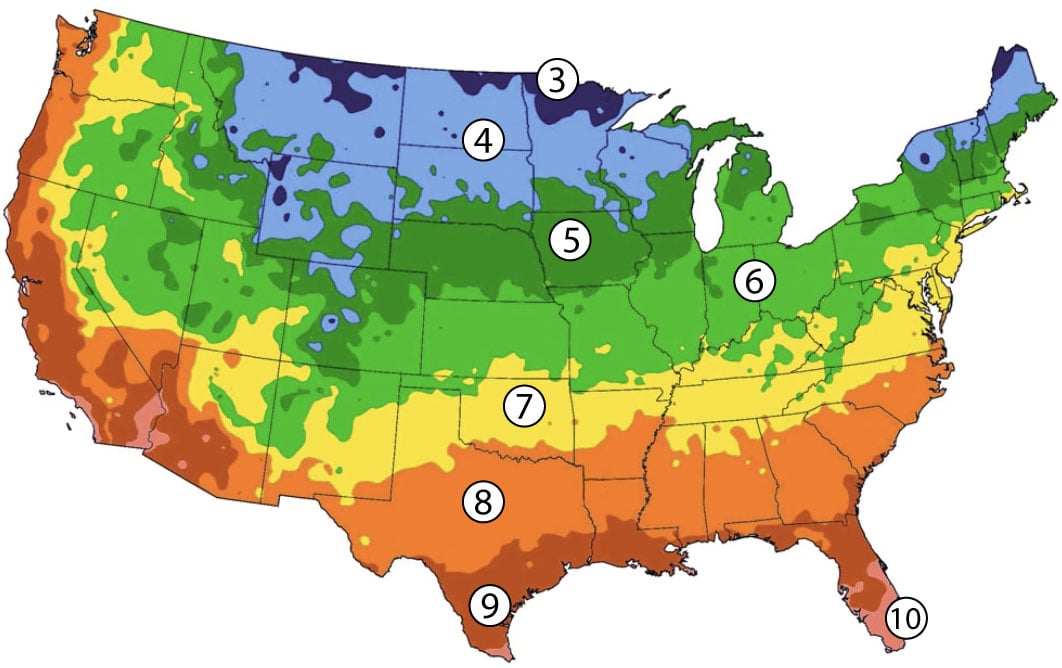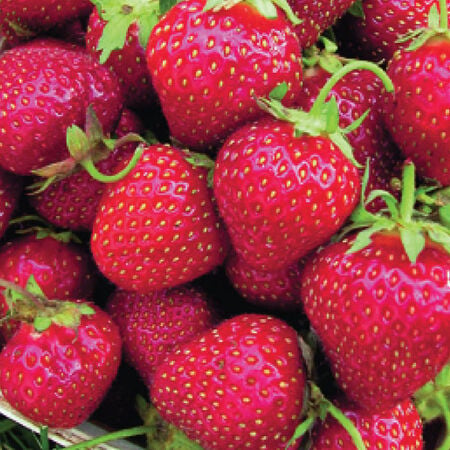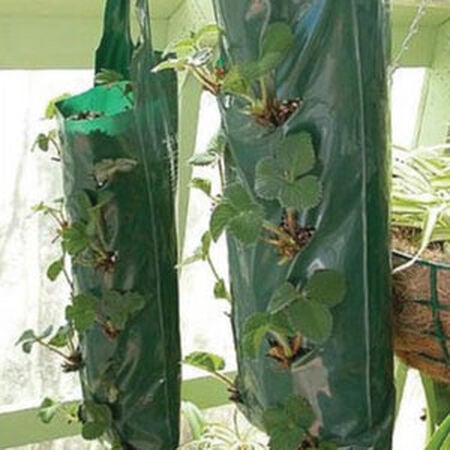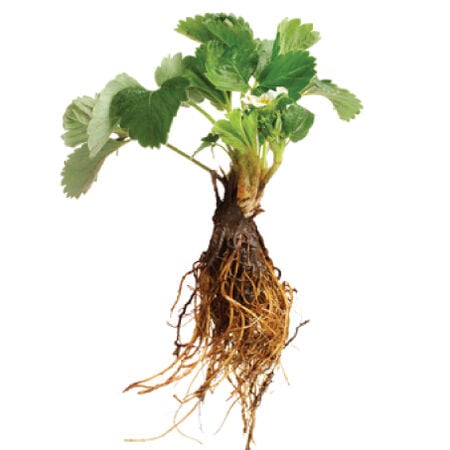Allstar, Strawberry Plants
Out of Stock
Key Attributes
Allstar produces high yields of large, sweet strawberries late in the season (late-spring to early summer). Once all the early and mid-season strawberries have stopped producing you can count on this "Allstar" to continue the harvest. Grows very well throughout the entire United States and is delicious for fresh eating or canning! As a Junebearer, the harvest season is concentrated over a few weeks, making it a good choice if you want to freeze or cook with a lot of berries at one time. Very good disease resistance.
Strawberry Details:
- Junebearing, produces a concentrated 2-3 week harvest.
- Late Junebearer, (late spring to early summer harvest).
- Grows 8" tall and 12-18" across.
- Disease resistant.
- Zones: 3-9, needs protection in zones 3 & 4.
Product Details
Plant Height
6-10"Botanical Name
Fragaria spp.Sow Depth
4-6"Breed
Open-pollinatedSun
Full SunTypes
JunebearingGrowing Conditions
Greenhouse ProductionUses
Edible FoliageLife Cycle
PerennialCategories
FruitDays To Maturity (# Days)
365Components
Growing Instructions
![]() Learning Download: How to Grow Strawberries
Learning Download: How to Grow Strawberries
Strawberries are frequently grown from bareroot, which are seeds that have developed and grown into roots, which are then easier to start in a garden. However, it is possible to start strawberry plants from seeds as well.
Before Planting: Bareroot strawberries can be planted at any time, strawberry seeds must be started indoors in to ensure they are ready to go when it comes to their normal growing season. To ensure strawberry seeds will grow when you plant them, you must first stratify them. To do this, place the strawberry seeds in an envelope or sealed plastic bag and store them in the refrigerator for a month.
Planting: For strawberry seeds, sow seeds thinly in 8-10 weeks before last frost in a fine soilless mix. Press seeds into moist mix and keep moist until plants emerge in 2-3 weeks. Keep soil temperature constantly at 60°F. Transplant to plug trays when true leaves emerge. Transplant outdoors anytime after last frost, 1′ apart. Tolerant to partial shade, and they prefer moist soil. For strawberry roots, healthy root systems will arrive fresh and ready to plant. Once they have arrived it is important to plant with a few days to keep the roots from drying out. If the strawberry roots can not be planted right away they should be stored at 28-35ºF to keep dormant. In general the strawberry roots can be planted in the ground, containers, or hanging pots. Strawberries are extremely adaptable and are grown in every state in the U.S. They will benefit from mulch such as straw, pine needles, or plastic. They prefer a soil rich in all the basic nutrients with a pH of 6-6.5.
Watering: Water the strawberries at least 1 inch a week.
Fertilizer: Begin the fertilizing process when seedlings are still indoors. Start fertilizing with liquid kelp every two weeks for the first month of growth.
Days to Maturity: Strawberries are ready to harvest as soon as they turn red.
Harvesting: When they are ready to harvest, cut the berry off at the stem. Do not pull the berry from the stem to harvest it. Unwashed strawberries can be stored in the refrigerator for three to five days.
Tips: When the strawberries are harvested, they should be slightly firm to the touch, but if strawberries are too mushy, they can be used to make jellies and jams.
Shipping Schedule
Strawberry roots will ship at the appropriate time for your planting zone. The chart below estimates when your strawberry roots will arrive. You will receive an email notifying you when your strawberry roots ship giving you a few days to prepare for planting.
This item’s size, weight, or shape may require an additional shipping surcharge based on the shipping location selected. Specific charges will be displayed during checkout. We are unable to take specific shipping dates at this time.
*This product is perishable and does not ship outside the United States.
|
 |
Our Seed Promise
 "Agriculture and seeds" provide the basis upon which our lives depend. We must protect this foundation as a safe and genetically stable source for future generations. For the benefit of all farmers, gardeners and consumers who want an alternative, we pledge that we do not knowingly buy or sell genetically engineered seeds or plants.
"Agriculture and seeds" provide the basis upon which our lives depend. We must protect this foundation as a safe and genetically stable source for future generations. For the benefit of all farmers, gardeners and consumers who want an alternative, we pledge that we do not knowingly buy or sell genetically engineered seeds or plants.
The mechanical transfer of genetic material outside of natural reproductive methods and between genera, families or kingdoms, poses great biological risks as well as economic, political, and cultural threats. We feel that genetically engineered varieties have been insufficiently tested prior to public release. More research and testing is necessary to further assess the potential risks of genetically engineered seeds. Further, we wish to support agricultural progress that leads to healthier soils, to genetically diverse agricultural ecosystems, and ultimately to healthy people and communities.
To learn more about the "Safe Seed Pledge" please visit www.councilforresponsiblegenetics.org.
Key Attributes
Product Details
Plant Height
6-10"Botanical Name
Fragaria spp.Sow Depth
4-6"Breed
Open-pollinatedSun
Full SunTypes
JunebearingGrowing Conditions
Greenhouse ProductionUses
Edible FoliageLife Cycle
PerennialCategories
FruitDays To Maturity (# Days)
365Components
Growing Instructions
![]() Learning Download: How to Grow Strawberries
Learning Download: How to Grow Strawberries
Strawberries are frequently grown from bareroot, which are seeds that have developed and grown into roots, which are then easier to start in a garden. However, it is possible to start strawberry plants from seeds as well.
Before Planting: Bareroot strawberries can be planted at any time, strawberry seeds must be started indoors in to ensure they are ready to go when it comes to their normal growing season. To ensure strawberry seeds will grow when you plant them, you must first stratify them. To do this, place the strawberry seeds in an envelope or sealed plastic bag and store them in the refrigerator for a month.
Planting: For strawberry seeds, sow seeds thinly in 8-10 weeks before last frost in a fine soilless mix. Press seeds into moist mix and keep moist until plants emerge in 2-3 weeks. Keep soil temperature constantly at 60°F. Transplant to plug trays when true leaves emerge. Transplant outdoors anytime after last frost, 1′ apart. Tolerant to partial shade, and they prefer moist soil. For strawberry roots, healthy root systems will arrive fresh and ready to plant. Once they have arrived it is important to plant with a few days to keep the roots from drying out. If the strawberry roots can not be planted right away they should be stored at 28-35ºF to keep dormant. In general the strawberry roots can be planted in the ground, containers, or hanging pots. Strawberries are extremely adaptable and are grown in every state in the U.S. They will benefit from mulch such as straw, pine needles, or plastic. They prefer a soil rich in all the basic nutrients with a pH of 6-6.5.
Watering: Water the strawberries at least 1 inch a week.
Fertilizer: Begin the fertilizing process when seedlings are still indoors. Start fertilizing with liquid kelp every two weeks for the first month of growth.
Days to Maturity: Strawberries are ready to harvest as soon as they turn red.
Harvesting: When they are ready to harvest, cut the berry off at the stem. Do not pull the berry from the stem to harvest it. Unwashed strawberries can be stored in the refrigerator for three to five days.
Tips: When the strawberries are harvested, they should be slightly firm to the touch, but if strawberries are too mushy, they can be used to make jellies and jams.
Shipping Schedule
Strawberry roots will ship at the appropriate time for your planting zone. The chart below estimates when your strawberry roots will arrive. You will receive an email notifying you when your strawberry roots ship giving you a few days to prepare for planting.
This item’s size, weight, or shape may require an additional shipping surcharge based on the shipping location selected. Specific charges will be displayed during checkout. We are unable to take specific shipping dates at this time.
*This product is perishable and does not ship outside the United States.
|
 |
Our Seed Promise
 "Agriculture and seeds" provide the basis upon which our lives depend. We must protect this foundation as a safe and genetically stable source for future generations. For the benefit of all farmers, gardeners and consumers who want an alternative, we pledge that we do not knowingly buy or sell genetically engineered seeds or plants.
"Agriculture and seeds" provide the basis upon which our lives depend. We must protect this foundation as a safe and genetically stable source for future generations. For the benefit of all farmers, gardeners and consumers who want an alternative, we pledge that we do not knowingly buy or sell genetically engineered seeds or plants.
The mechanical transfer of genetic material outside of natural reproductive methods and between genera, families or kingdoms, poses great biological risks as well as economic, political, and cultural threats. We feel that genetically engineered varieties have been insufficiently tested prior to public release. More research and testing is necessary to further assess the potential risks of genetically engineered seeds. Further, we wish to support agricultural progress that leads to healthier soils, to genetically diverse agricultural ecosystems, and ultimately to healthy people and communities.
To learn more about the "Safe Seed Pledge" please visit www.councilforresponsiblegenetics.org.






